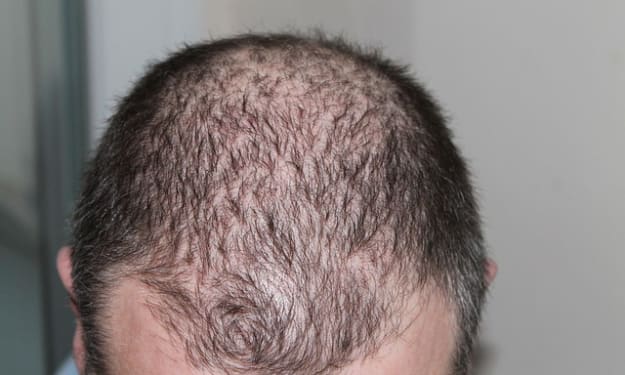Scientists discovered a possible treatment for baldness from hairy moles and it can be injected like Botox
Read the article to claim your free prize!

Promising discoveries by researchers suggest that the molecules found in mole hair could hold the key to a revolutionary treatment for baldness, similar to the effects of Botox. This breakthrough treatment, if successful, could revolutionize the field of hair restoration.
While experts agree that the treatment has only been tested on mouse models and its effectiveness on human hair remains uncertain, the potential lies within the most unexpected of places.
Imagine that peculiarly determined single hair sprouting defiantly from an inconspicuous mole on your body. Yes, that one. It turns out that a team of researchers has identified a particular molecule responsible for excessive hair growth in skin moles. This discovery offers a tantalizing possibility for combating age-related hair loss.
The solution lies in a simple rearrangement of these molecules.
“This is a monumental breakthrough. Hair loss affects millions of men and women, yet current treatments only provide temporary relief,” remarked Maksim Plikus, lead study author and professor of developmental and cell biology at the University of California Irvine, in an interview with Medical News Today.
He added, “What we have uncovered holds the potential for disruptive innovation. The field is primed for a new compound that can target hair follicle stem cells and awaken them to promote new hair growth.”
Insights from the Study on Baldness The study, published in the esteemed journal Nature, details the team’s findings regarding osteopontin, a molecule not previously associated with hair growth, which demonstrated heightened activity in hairy mole skin of mouse models.
Furthermore, the researchers observed elevated levels of osteopontin in samples of human hairy skin moles compared to neighboring normal skin, confirming their theory.
The researchers propose that injecting osteopontin into the scalp of individuals with baldness could reactivate dormant hair follicles, much like a Botox-like procedure.
“Our inspiration stems from nature itself — millions of people possess moles that sprout lengthy hair. Molecules abundant in such moles might hold the key to stimulating hair stem cells,” Plikus explained. “Osteopontin, prevalent in hairy skin moles, when micro-injected into the skin, vigorously activates hair stem cells and promotes new hair growth. This discovery unveils a novel protein that induces hair growth.”
Decoding the Hair Molecule: Osteopontin Dr. Michele Green, a cosmetic dermatologist in New York unaffiliated with the study, revealed to Medical News Today that osteopontin is a signaling molecule produced by senescent pigment cells called melanocytes, an unexpected source for cell regeneration.
“Although senescent cells are typically associated with aging, tissue death, cancer, Alzheimer’s, and cardiovascular disease, they can also regulate or trigger tissue growth and contribute to wound healing,” Green explained.
She further elaborated, “Under specific signals, immature stem cells can either remain dormant or become active to regenerate specific cells or tissues. These signals influencing stem cells can be manipulated to instruct them to perform specific tasks. In this case, researchers sought to alter these signals to push the stem cells in hair follicles into a hyperactive state, resulting in excessive hair growth.”
The Potential Impact of Hair Growth Treatment Dr. Ryan Welter, CEO of Regeneris Medical and founder of New England Hair Restoration, who was not involved in the study, expressed his fascination with using senescent cells for hair regrowth, particularly considering their typically detrimental role in natural aging processes.
“It appears that the unique secretome of aged melanocytes stimulates the hair follicle stem cell niche, thus promoting hair growth during the anagen phase. The melanocytes derived from mole hair will be of great interest following this study,” stated Welter.
However, he cautioned that while advancements in mouse studies have been substantial, their translation into human treatments remains a lengthy process. A true cure for baldness may still be a considerable distance away.
Potential Limitations and Future Prospects Plikus added that the resulting hair growth from this treatment would not match the wild nature of mole hair, as the characteristics of the original stimulated hair follicles would remain unchanged.
“Hair loss stems from a decrease in essential signaling proteins within hair follicles that typically stimulate hair stem cells,” Plikus clarified. “Consequently, for common types of hair loss, hair stem cells remain dormant for prolonged periods despite being intact. This makes solving the problem an arduous task.”
Presently, only two widely recognized brands, Rogaine and Propecia, have demonstrated varying degrees of efficacy in combating hair loss. However, they are far from perfect and may not suit everyone.
Plikus, who also serves as co-founder and chief scientific officer of Amplifica, a California-based biotech company, intends to commence human trials for this potential hair treatment in the following weeks.
“A compound capable of achieving such effects without requiring frequent administration could revolutionize a market currently dominated by costly and invasive hair transplantation surgeries and daily medications,” Plikus affirmed.
In conclusion, while the discovery of these mole hair molecules shows tremendous promise, it is crucial to temper expectations with the knowledge that further research and trials are needed before a definitive solution for baldness can be realized.
GET YOUR FREE E-BOOK ON HAIR LOSS NOW: CLICK HERE






Comments
There are no comments for this story
Be the first to respond and start the conversation.